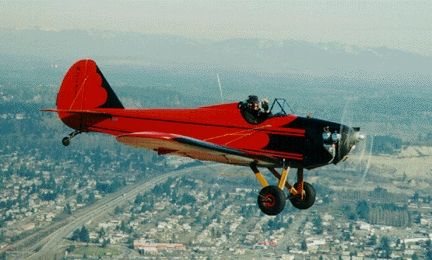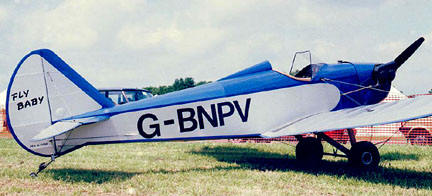In 1957, the Experimental
Aircraft Association invited its membership to design, build and
submit designs for a low-cost, easy-to-build, and easy-to-fly
folding wing airplane for judging in a competition in conjunction
with the National Fly-in in 1959. For various reasons, the
competition was postponed until 1962. Pete Bowers, of Seattle,
Washington
 met
the specifications for a homebuilt airplane including requirements
that, among other things, it could be built in a space 7'x8'x20',
which was equivalent to an average home garage. met
the specifications for a homebuilt airplane including requirements
that, among other things, it could be built in a space 7'x8'x20',
which was equivalent to an average home garage.
As the plans state, "Great emphasis [was] placed upon
safe flight characteristics and good low speed performance for
takeoff and landing at some sacrifice of high speed." (Fly Baby
plans, "Introduction", p. A) Also crucial to the design were simple
wood construction techniques using fairly common tools available to
average people.
Bowers won the EAA design award with the Fly Baby,
and was met with howling demand for plans.
This airplane has been built with an impressive
array of modifications personal to builders, and the original design
has been modified by Bowers himself into a parasol monoplane (model
1B, kinda like a bi-plane without the lower wing), and bi-plane
(model 1C). A wide variety of engines have been fitted, as have
floats for marine models.
Performance has been more than satisfactory. The
low wing loading (about 7 pounds per square foot) gives it very
friendly flying characteristics, and, before the FAA changed the
rules over this sort of thing, the Fly Baby even towed gliders.
Pete Bowers rendered a uniquely lovable design
that will likely never disappear as long as individual crazies
insist on gluing together man-sized model airplanes and flying them
on their own. He did guys like me a big favor.
Above courtesy of http://www.two--four.net/FlyBaby/FlyBaby.htm |


 met
the specifications for a homebuilt airplane including requirements
that, among other things, it could be built in a space 7'x8'x20',
which was equivalent to an average home garage.
met
the specifications for a homebuilt airplane including requirements
that, among other things, it could be built in a space 7'x8'x20',
which was equivalent to an average home garage.